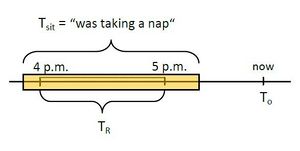Difference between revisions of "Aspect"
m (→Perfective vs. imperfective aspect in English: corrected minor typo --~~~~) |
|||
| Line 9: | Line 9: | ||
The [[perfective aspect]] “looks at the situation from outside, without necessarily distinguishing any of the internal structure of the situation, whereas the [[imperfective|imperfective aspect]] looks at the situation from inside, and as such is crucially concerned with the internal structure of the situation” (Comrie 1976:4; cf. also Bache 1995: 269). Looking at an event from the outside means focusing on the external situation as a whole, i.e. in its entirety and as completed. | The [[perfective aspect]] “looks at the situation from outside, without necessarily distinguishing any of the internal structure of the situation, whereas the [[imperfective|imperfective aspect]] looks at the situation from inside, and as such is crucially concerned with the internal structure of the situation” (Comrie 1976:4; cf. also Bache 1995: 269). Looking at an event from the outside means focusing on the external situation as a whole, i.e. in its entirety and as completed. | ||
| − | Huddleston and Pullum (2002) distinguish perfectivity and imperfectivity by relating T<sub>r</sub> (the 'time referred to') and T<sub>sit</sub> (the 'situational time') to each other. Perfective aspectuality is accordingly | + | Huddleston and Pullum (2002) distinguish perfectivity and imperfectivity by relating T<sub>r</sub> (the 'time referred to') and T<sub>sit</sub> (the 'situational time') to each other. Perfective aspectuality is accordingly defined as a property of situations in which T<sub>r</sub> does not entirely include T<sub>sit</sub>; imperfectivity is defined as a property of situations in which T<sub>r</sub> as entirely included in T<sub>sit</sub> (Huddleston & Pullum 2002: 124f.). |
===Example=== | ===Example=== | ||
Latest revision as of 02:29, 15 January 2019
Definition
Aspect is an inflectional category-system of verbs that has to do with the internal temporal constituency of an event. It is a cover term for those properties of a sentence that constitute the temporal structure of the event denoted by the verb and its arguments. Not all verbs have the same aspectual properties and so may belong to different aspectual classes. The aspect of a sentence is in many languages expressed syntactically and/or morpho-phonologically.
Aspect vs. tense
In terms of the tense-aspect system of Klein (1994), the difference between tense and aspect can be described as follows: Aspect relates the topic time to the time of situation, whereas tense tense relates the topic time to the moment of utterance.
Perfective vs. imperfective aspect in English
The opposition between perfective aspect and imperfective aspect is one of the most important aspectual distinctions encoded in natural languages. The perfective aspect “looks at the situation from outside, without necessarily distinguishing any of the internal structure of the situation, whereas the imperfective aspect looks at the situation from inside, and as such is crucially concerned with the internal structure of the situation” (Comrie 1976:4; cf. also Bache 1995: 269). Looking at an event from the outside means focusing on the external situation as a whole, i.e. in its entirety and as completed.
Huddleston and Pullum (2002) distinguish perfectivity and imperfectivity by relating Tr (the 'time referred to') and Tsit (the 'situational time') to each other. Perfective aspectuality is accordingly defined as a property of situations in which Tr does not entirely include Tsit; imperfectivity is defined as a property of situations in which Tr as entirely included in Tsit (Huddleston & Pullum 2002: 124f.).
Example
- A: "What did you do yesterday between 4 and 5 o'clock?"
- B1: "I took a nap."
- B2: "I was taking a nap."
In B1, Tr ('4-5 o'clock') is not fully included in Tsit (the time of the nap); in B2, Tr ('4-5 o'clock') is fully included in Tsit (the time of the nap):
Perfective aspect
|
Imperfective aspect
|
Progressive vs. non-progressive aspect
The progressive aspect is often viewed as a sub-category of the imperfective aspect (e.g. Comrie 1976: 25). It forms a sub-category of continuous situations within the class of imperfective ones. In English, the progressive aspect is used to indicate imperfectivity in combination with dynamic (non-stative) situations, but it is not regularly used with stative verbs.
Aspectual categories
References
- Bache, Carl. 1995. The Study of Aspect, Tense and Action. Frankfurt: Lang.
- Comrie, B. 1976. Aspect. Cambridge: Cambridge University Press.
- Dowty, D. 1979. Word meaning and Montague grammar: the semantics of verbs and times in generative semantics and in Montague's PTQ, Reidel, Dordrecht
- Tenny, C. 1987. Grammaticalizing aspect and affectedness, MIT linguistics dissertations.
- Verkuyl, H.J. 1993. A theory of aspectuality: the interaction between temporal and atemporal structure, Cambridge University Press, Cambrigde
- Verkuyl, H.J. 1972. On the compositional nature of the aspects, Reidel, Dordrecht.
Link
Utrecht Lexicon of Linguistics